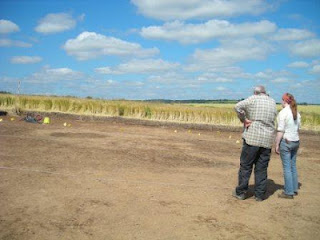Hi there, I’m Astrid, student at Aberdeen University
(about to enter third year) and I’m very happy of being part of the SERF
project for this year’s session.
Another very hot, exciting day at Leadketty comes to an end.
Our site consists of three trenches. In the first trench we revealed many round
features marking a circle. The second trench, in which I’m working, consists of
a mini henge feature with a centre. The south terminal of the henge is burnt
and we also found burnings around it. In addition to this, under the top soil we
found medieval furrows. The features of postholes came to the surface in our
third trench. Today we made a very exciting find in the third trench which was
a worked flint.
We started our day by finishing our pre-excavation plan drawings.
The original features that were dug up will be lost during the process of
excavation and due to this it is crucial to take exact records of the site
before excavation can start. The drawings not only include the co-ordinates of
the feature but also enable us to re-view the feature once it has been
excavated.
After we finished our drawings we were shown how to take
photographs of the features we are about to excavate. It is important that
there are no tools, people or shadows included in the picture. The photograph
should only be taken when there are scales put up next to the feature. We
should make sure to take a straight picture and to record the photograph in the
record book.
After the recording we started to excavate the centre
feature of the henge in half section. During this process it is important to
keep to the feature’s edge and to not include the natural soil. We are working
by stratigraphy. While excavating the features we have to take precise notes on
the texture, the colour and other details. It is also significant to take
samples of the layers we are excavating.
I’m really thrilled what tomorrow might bring to the surface
and very proud of being part of such a great project and team!






